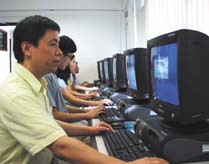|
|

A spin-off from
mathematical research of fluid-dynamics may one day help provide more
accurate mid-term weather forecasts for Hong Kong.
 The research,
at The Chinese University of Hong Kong, uses nonlinear partial differential
equations to study the characteristics of air or gas The research,
at The Chinese University of Hong Kong, uses nonlinear partial differential
equations to study the characteristics of air or gas
 |
Prof
Xin with some of his students. |
flows.
 Immediate
benefits are solutions to help designers of materials used in high
speed flight. Using the same nonlinear partial differential equations,
notably the Navier-Stokes equation first evolved in the 18th century,
Principal Investigator Prof Zhou-ping Xin is also looking at how topography
of the sea bed affects air circulation and therefore the weather. Immediate
benefits are solutions to help designers of materials used in high
speed flight. Using the same nonlinear partial differential equations,
notably the Navier-Stokes equation first evolved in the 18th century,
Principal Investigator Prof Zhou-ping Xin is also looking at how topography
of the sea bed affects air circulation and therefore the weather.
 “It’s
possible that we can use the calculations to help predict with some
accuracy trends in the weather for the mid-term, from four weeks to
several months. That would be very useful for Hong Kong.” “It’s
possible that we can use the calculations to help predict with some
accuracy trends in the weather for the mid-term, from four weeks to
several months. That would be very useful for Hong Kong.”
 Prof Xin
added: “Many phenomena in the physical world are governed by
nonlinear partial differential equations which enable us to describe
the phenomena mathematically. Prof Xin
added: “Many phenomena in the physical world are governed by
nonlinear partial differential equations which enable us to describe
the phenomena mathematically.
 “Doing
this means we can assimilate many situations, across many fields of
physical science, some of which may be impossible to assimilate or
be too expensive to mimic experimentally.” “Doing
this means we can assimilate many situations, across many fields of
physical science, some of which may be impossible to assimilate or
be too expensive to mimic experimentally.”
 In aerodynamics,
the researchers have added to analysis and understanding of shock
waves caused when air or gases flow at supersonic speeds. In aerodynamics,
the researchers have added to analysis and understanding of shock
waves caused when air or gases flow at supersonic speeds.
 Specifically,
they have verified design criteria for jet engine nozzles where gases
are converted from subsonic to supersonic speeds. They have also come
up with new understandings in aerodynamics. Specifically,
they have verified design criteria for jet engine nozzles where gases
are converted from subsonic to supersonic speeds. They have also come
up with new understandings in aerodynamics.
 Previously
it was thought that the shock wave, forming from supersonic flow past
a sharp body was unstable. “Our theory suggests, in fact, that
the shock wave is globally stable,” said Prof Xin. Previously
it was thought that the shock wave, forming from supersonic flow past
a sharp body was unstable. “Our theory suggests, in fact, that
the shock wave is globally stable,” said Prof Xin.
 Calculations
that assimilate the behaviour of “space shapes” in flight
far greater than the speed of sound can be easily made, without the
expense of wind tunnel experiments, he added. Calculations
that assimilate the behaviour of “space shapes” in flight
far greater than the speed of sound can be easily made, without the
expense of wind tunnel experiments, he added.
 “The
numerical code resulting from the research is so reliable that it
can form the basis of the initial design of space shapes.” “The
numerical code resulting from the research is so reliable that it
can form the basis of the initial design of space shapes.”
 The mathematical
methods developed by the researchers can be used to solve other multi-dimensional
problems. The mathematical
methods developed by the researchers can be used to solve other multi-dimensional
problems.
 Another
possible application, said Prof Xin, could be predicting trends for
the Hong Kong stock market. Another
possible application, said Prof Xin, could be predicting trends for
the Hong Kong stock market.
 “The
mathematical model would be similar to one for weather prediction.”
Prof Xin said: “The research was about achieving a better theoretical
understanding of the subject, so the uses of these models go beyond
event-specific aerodynamics and military applications. “The
mathematical model would be similar to one for weather prediction.”
Prof Xin said: “The research was about achieving a better theoretical
understanding of the subject, so the uses of these models go beyond
event-specific aerodynamics and military applications.
 “It’s
an important analysis that bridges engineering and pure mathematics,
and can equally be applied to population dynamics or meteorology. “It’s
an important analysis that bridges engineering and pure mathematics,
and can equally be applied to population dynamics or meteorology.
 “We
hope that our theories can provide valuable insights and guidelines
for engineers for their future work.” The research, said Prof
Xin, is an example of how international Hong Kong is becoming academically. “We
hope that our theories can provide valuable insights and guidelines
for engineers for their future work.” The research, said Prof
Xin, is an example of how international Hong Kong is becoming academically.
 Last year,
the International Congress of Mathematicians invited Prof Xin to make
a presentation on his work. Addressing the congress, which meets only
once every four years, is considered prestigious. Last year,
the International Congress of Mathematicians invited Prof Xin to make
a presentation on his work. Addressing the congress, which meets only
once every four years, is considered prestigious.
 “The
fact that Hong Kong is sponsoring research of this nature also shows
its international outlook,” said Prof Xin. “The
fact that Hong Kong is sponsoring research of this nature also shows
its international outlook,” said Prof Xin.
Principal
Investigator
Prof Zhou-ping Xin : zpxin@ims.cuhk.hk

|

